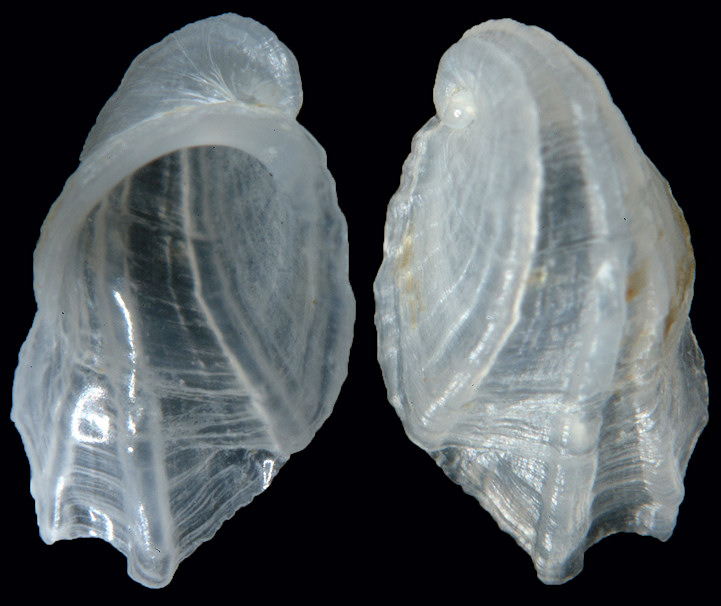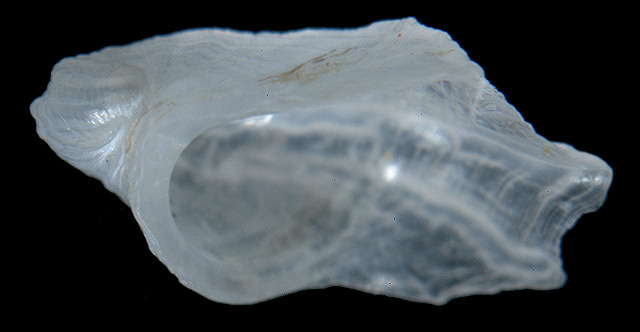|
David's specimen is referable to Cyclothyca
pacei Petuch, 1987 (22; pl. 4, figures 6,7). It seems to prosper on
the shells of living pectinids and Spondylus americanus.
According to the original description, in which the genus name is
consistently misspelled "Cyclotheca," the favored host is
Chlamys imbricata.
[= Caribachlamys pellucens (Linnaeus,
1758); see below]
Cyclothyca was placed in the Capulidae by
Stearns (1891: 212) and Petuch (loc. cit.) whereas the
affinities of the usually much larger Amathina tricarinata (Linné,
1767: 1259: sp. 762; see below for URL), the monotype of its genus,
Amathina Gray (1842: 63; see Gray, 1847: 157; genus 267 <http://www.biodiversitylibrary.org/item/46217#page/659/mode/1u>),
are with the only remotely-related Heterobranchia.
But wait! I have just examined some juvenile C.
pacei shells and discovered that, like the Heterobranchia, they are
heterostrophic. That is, the embryonic shell is sinistral, and the axis
of coil rotates through about 270 degrees at the metamorphosis to the
teleoconch. The shells of the two nominal taxa are in fact very close!
So close that, allowing for differences in size, and accounting for the
natural variability of shell form induced by irregularities of substrate
topology, they could be the same species! In any event the resemblance
between "Cyclothyca" pacei Petuch and Cyclothyca Stearns
1891 [Type species Capulus corrugatus Stearns, 1891*
<http://www.biodiversitylibrary.org/item/53445#page/256/mode/1up>;
<http://www.biodiversitylibrary.org/item/53445#page/271/mode/1up>]
is infinitesimal compared to it and A. tricarinata <http://www.conchology.be/?t=68&u=382584&g=2b1241a09fd2e68953efd13a83abee20&q=1a175e0a6b6b7bcd00fdd00b49f69fa2>.
In its specialized niche, "Cyclothyca" pacei
is a common species. In the original description it was noted that
Bob Pace found up to five C. pacei on a single living
Caribachlamys pellucens (Linnaeus, 1758)
<http://www.jaxshells.org/imbric.htm> (Petuch, loc. cit.).
Wayne Harland (pers. comm., 21 June, 2011) recalls finding it commonly
on Spondylus spp. and certain Caribachlamys off Broward
Co., and I have found several dozen shells of this ectosymbiont in
Spondylus americanus
<http://www.jaxshells.org/samerica.htm> grunge from off SE FL
provided me by Tom Honker and by Jeff Whyman. Given that
Caribachlamys spp. and S. americanus have been
ultra-favorites with collectors for a long time, it is astounding that
C. pacei could have escaped detection from the dawn of snorkel and
SCUBA collecting in that region as long as it did. Could it be that this
snail is simply an ecophenotypic descendant of an immigrant A.
tricarinata? The latter is known to be associated with oysters and
pen shells in Japan. Maybe, when introduced to, say, Biscayne Bay in
bilge water pumped out from one of the Japanese merchant fleet sometime in the
middle third of 20th Century, it took up with the most available hosts
in the vicinity and rapidly adapted to those substrates?
* Although Petuch (loc. cit.) reported Cyclotheca corrugata
Stearns [sic (orthography; neither parentheses nor date)] as
being based solely on a 19th Century lot from Nicaragua and its Panamic
provenance had been questioned earlier (Keen, 1971: 467), any doubt had
been removed with James McLean's 1974 collection of the species in Costa
Rica (Keen and Coan, 1975: 22)
and its subsequent rediscovery in Nicaragua
(Garcia, 1996).
More recently it has been found in Ecuador (Kate Clark, pers. comm. Feb.
26, 2000.
Garcia, E.F., 1996. The rediscovery of
Cyclothyca corrugata Stearns, 1890. American Conchologist 24(4):
19. December.
Gray, J.E., 1842. [Mollusca] pp. 48-92 in: Synopsis of the
Contents of the British Museum 44th edition. G. Woodfall and Son,
London. [not seen; see Gray (1847: 157; genus 267: <http://www.biodiversitylibrary.org/item/46217#page/659/mode/1up>)].
Gray, J.E., 1847. A list of the genera of Recent Mollusca, their
synonyma and types. Zoological Society of London, Proceedings for
1847 [15](178): 129-219. Nov. 30.
<http://www.biodiversitylibrary.org/item/46217#page/631/mode/1up>.
Keen, A.M., 1971. Sea shells of tropical west America. Stanford
Univ. Press, CA, pp. 1-1064 incl. numerous figs. + 22 pls. Sept. 1.
Keen, A.M. and E. Coan, 1975. Sea shells of tropical west America:
additions and corrections to 1975. Western Society of Malacologists
Occasional Paper 1. 66 pp. June 22 [p. 22; vidi 1988 reprint]
Linné, C. von, 1767.
Systema Naturae, seu per regna tria naturae,
secundum classes, ordines, genera, species, cum characteribus,
differentiis, synonymis, locis. Tomus II Editio
duodecima, reformata.
Laurentius Salvius, Holmia (Stockholm). Pp. 533-1327.
<http://gdz.sub.uni-goettingen.de/no_cache/dms/load/img/?IDDOC=215230>
Petuch,
E.J., 1987. New Caribbean molluscan faunas. Coastal Education
Research Foundation, Charlottesville, VA, pp. 1-154 incl. 29 pls. +
A1-A4.
Stearns, R.E.C., 1891. Scientific results of expeditions of the U.S.
Fish Commissions Steamer Albatross. Proceedings of the United States
National Museum 13: 205-225, pls. 15-17. [These are the proceedings
for the year 1890, but, based on Library of Congress imprint, not
published until 1891;
see URL's in text above.] |

